API Audit: Financial Ratio Analysis and Internal Control Review
VerifiedAdded on 2023/03/17
|21
|4270
|45
Report
AI Summary
This report presents an audit analysis of Always Precise Instrument Private Limited (API), a manufacturer and supplier of small military equipment. It identifies potential audit risks by performing financial ratio analysis, highlighting concerns such as increased current ratio, quick asset ratio fluctuations, declining return on equity and assets, and gross margin variations. The report also assesses weaknesses in API's internal control system, particularly within the inventory system, including authorization issues and potential manipulation of purchase orders and production orders. Furthermore, the document outlines appropriate audit procedures and sampling processes for key audit assertions, emphasizing the need for thorough examination of inventory balances, accounts receivable, and debt-to-equity ratios. The report concludes by recommending improvements to internal controls and suggesting specific audit measures to minimize identified risks, ensuring a more accurate and reliable financial reporting process. Desklib provides students access to similar past papers and solved assignments for academic assistance.
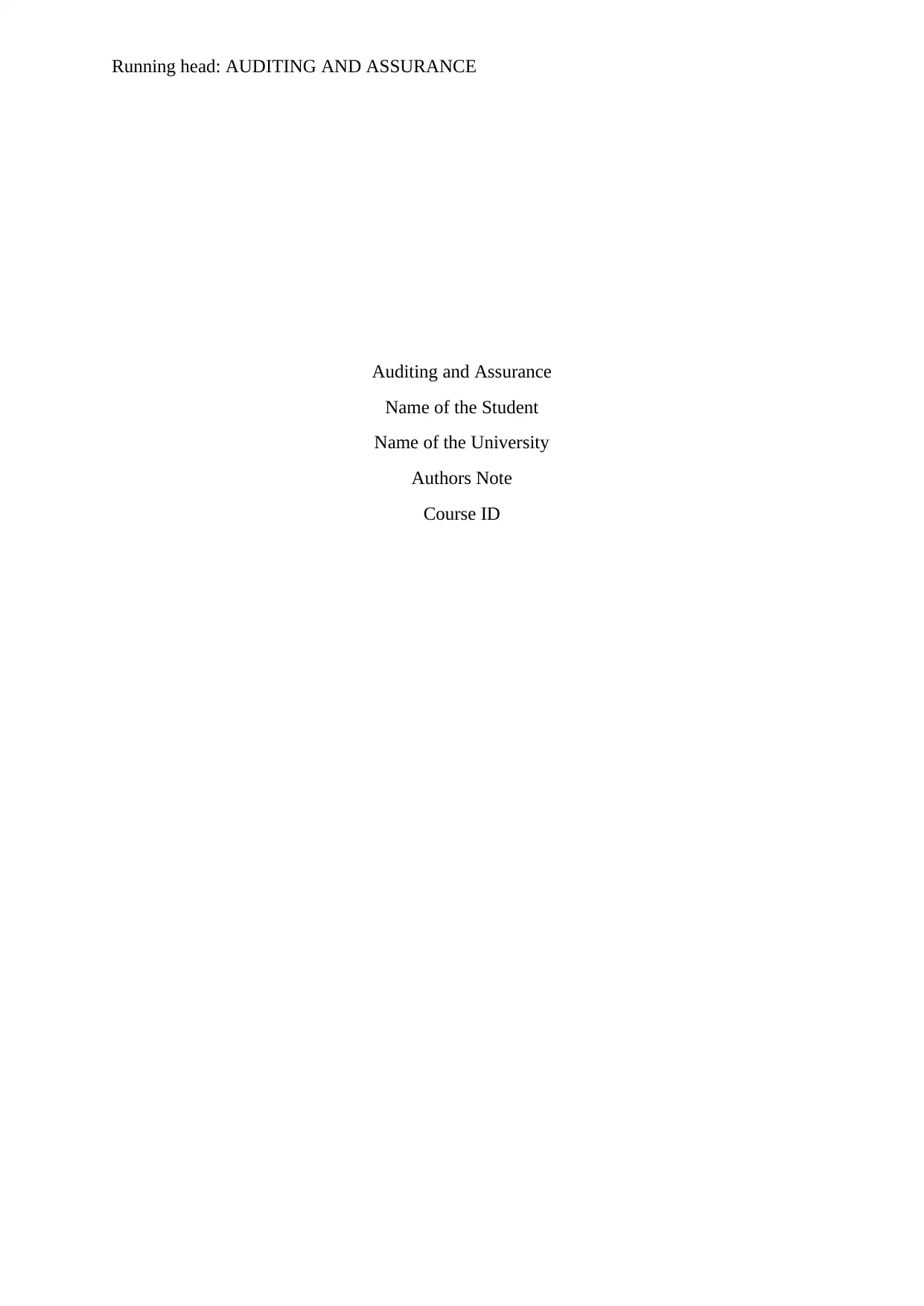
Running head: AUDITING AND ASSURANCE
Auditing and Assurance
Name of the Student
Name of the University
Authors Note
Course ID
Auditing and Assurance
Name of the Student
Name of the University
Authors Note
Course ID
Paraphrase This Document
Need a fresh take? Get an instant paraphrase of this document with our AI Paraphraser
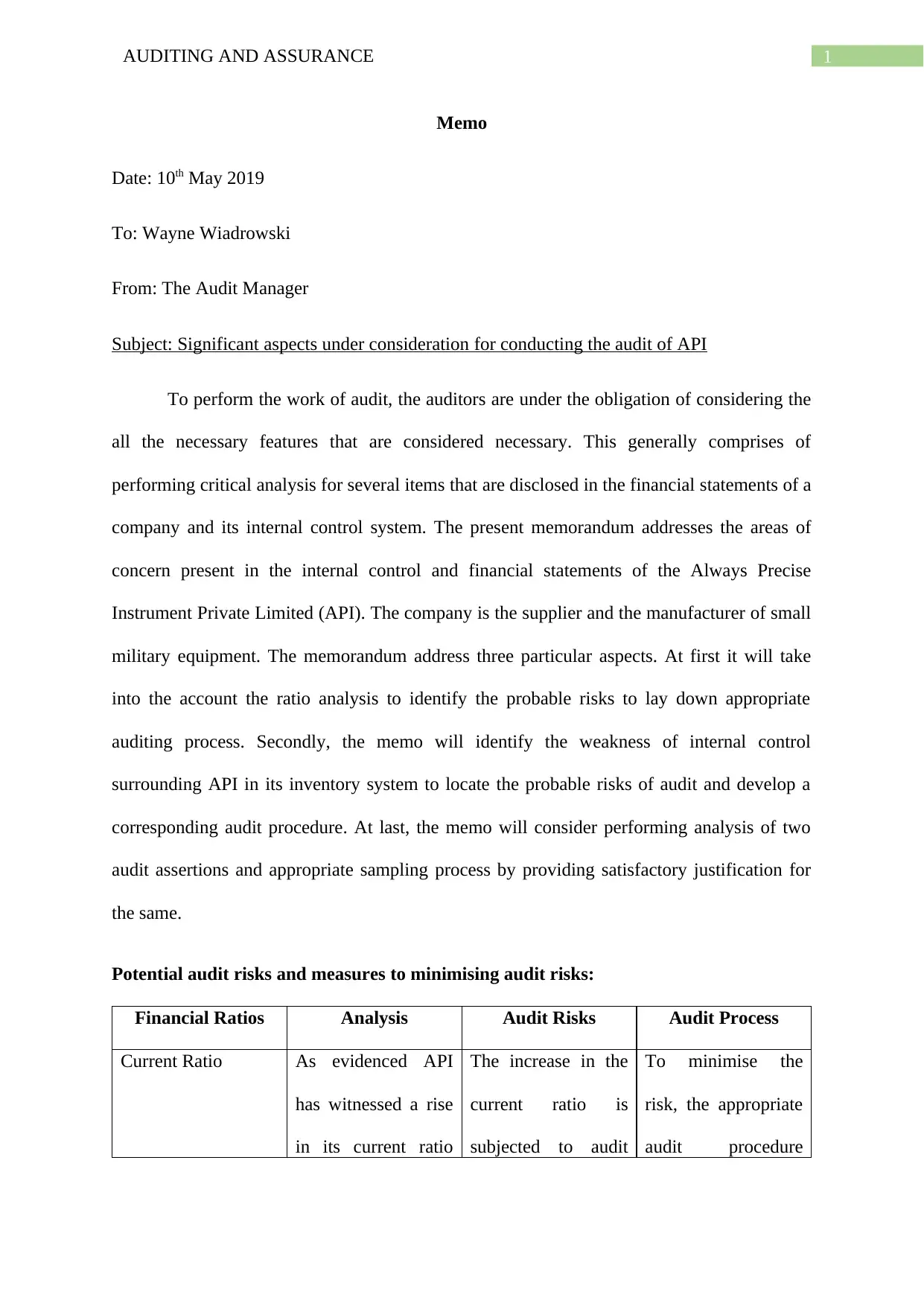
1AUDITING AND ASSURANCE
Memo
Date: 10th May 2019
To: Wayne Wiadrowski
From: The Audit Manager
Subject: Significant aspects under consideration for conducting the audit of API
To perform the work of audit, the auditors are under the obligation of considering the
all the necessary features that are considered necessary. This generally comprises of
performing critical analysis for several items that are disclosed in the financial statements of a
company and its internal control system. The present memorandum addresses the areas of
concern present in the internal control and financial statements of the Always Precise
Instrument Private Limited (API). The company is the supplier and the manufacturer of small
military equipment. The memorandum address three particular aspects. At first it will take
into the account the ratio analysis to identify the probable risks to lay down appropriate
auditing process. Secondly, the memo will identify the weakness of internal control
surrounding API in its inventory system to locate the probable risks of audit and develop a
corresponding audit procedure. At last, the memo will consider performing analysis of two
audit assertions and appropriate sampling process by providing satisfactory justification for
the same.
Potential audit risks and measures to minimising audit risks:
Financial Ratios Analysis Audit Risks Audit Process
Current Ratio As evidenced API
has witnessed a rise
in its current ratio
The increase in the
current ratio is
subjected to audit
To minimise the
risk, the appropriate
audit procedure
Memo
Date: 10th May 2019
To: Wayne Wiadrowski
From: The Audit Manager
Subject: Significant aspects under consideration for conducting the audit of API
To perform the work of audit, the auditors are under the obligation of considering the
all the necessary features that are considered necessary. This generally comprises of
performing critical analysis for several items that are disclosed in the financial statements of a
company and its internal control system. The present memorandum addresses the areas of
concern present in the internal control and financial statements of the Always Precise
Instrument Private Limited (API). The company is the supplier and the manufacturer of small
military equipment. The memorandum address three particular aspects. At first it will take
into the account the ratio analysis to identify the probable risks to lay down appropriate
auditing process. Secondly, the memo will identify the weakness of internal control
surrounding API in its inventory system to locate the probable risks of audit and develop a
corresponding audit procedure. At last, the memo will consider performing analysis of two
audit assertions and appropriate sampling process by providing satisfactory justification for
the same.
Potential audit risks and measures to minimising audit risks:
Financial Ratios Analysis Audit Risks Audit Process
Current Ratio As evidenced API
has witnessed a rise
in its current ratio
The increase in the
current ratio is
subjected to audit
To minimise the
risk, the appropriate
audit procedure
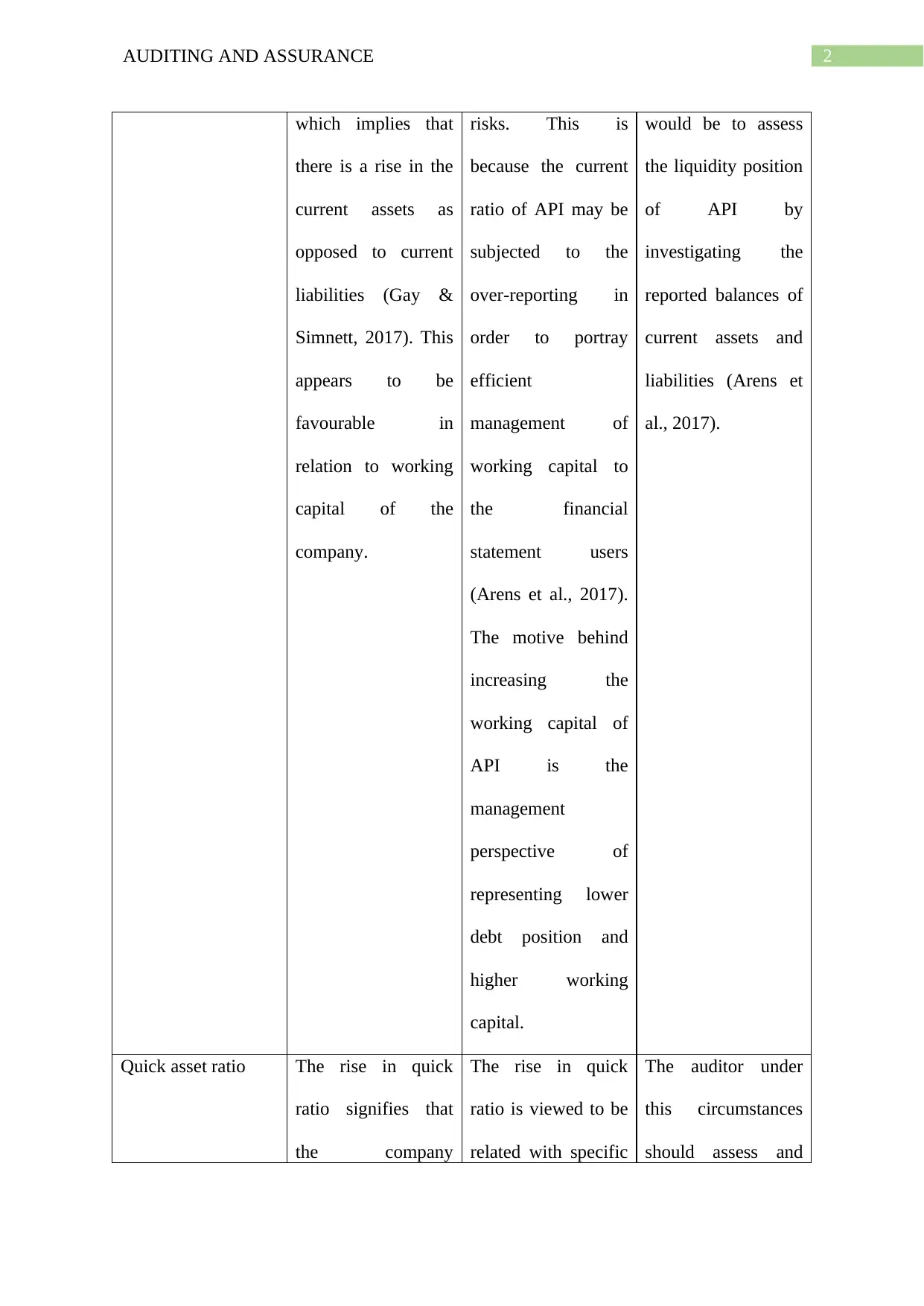
2AUDITING AND ASSURANCE
which implies that
there is a rise in the
current assets as
opposed to current
liabilities (Gay &
Simnett, 2017). This
appears to be
favourable in
relation to working
capital of the
company.
risks. This is
because the current
ratio of API may be
subjected to the
over-reporting in
order to portray
efficient
management of
working capital to
the financial
statement users
(Arens et al., 2017).
The motive behind
increasing the
working capital of
API is the
management
perspective of
representing lower
debt position and
higher working
capital.
would be to assess
the liquidity position
of API by
investigating the
reported balances of
current assets and
liabilities (Arens et
al., 2017).
Quick asset ratio The rise in quick
ratio signifies that
the company
The rise in quick
ratio is viewed to be
related with specific
The auditor under
this circumstances
should assess and
which implies that
there is a rise in the
current assets as
opposed to current
liabilities (Gay &
Simnett, 2017). This
appears to be
favourable in
relation to working
capital of the
company.
risks. This is
because the current
ratio of API may be
subjected to the
over-reporting in
order to portray
efficient
management of
working capital to
the financial
statement users
(Arens et al., 2017).
The motive behind
increasing the
working capital of
API is the
management
perspective of
representing lower
debt position and
higher working
capital.
would be to assess
the liquidity position
of API by
investigating the
reported balances of
current assets and
liabilities (Arens et
al., 2017).
Quick asset ratio The rise in quick
ratio signifies that
the company
The rise in quick
ratio is viewed to be
related with specific
The auditor under
this circumstances
should assess and
⊘ This is a preview!⊘
Do you want full access?
Subscribe today to unlock all pages.

Trusted by 1+ million students worldwide
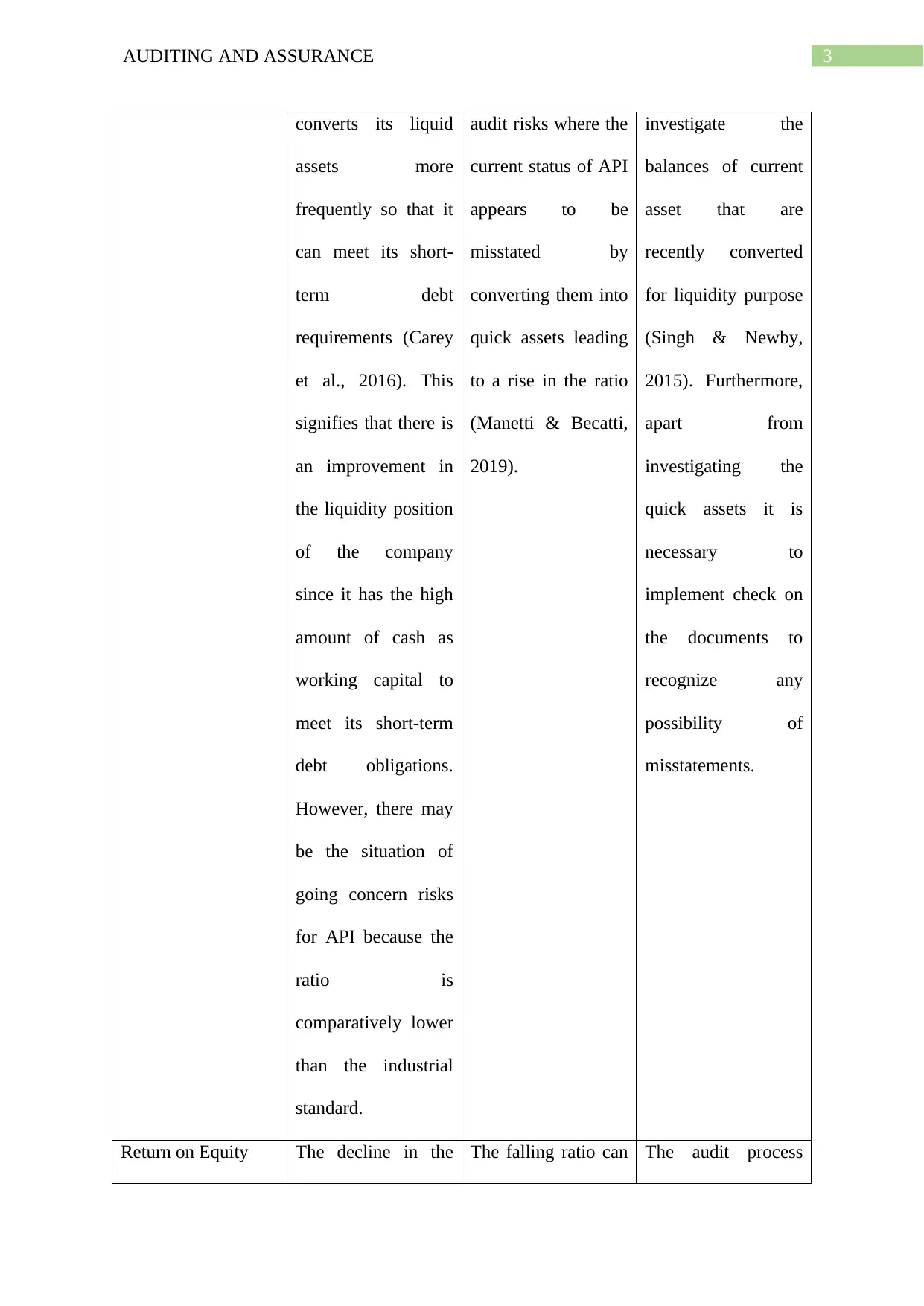
3AUDITING AND ASSURANCE
converts its liquid
assets more
frequently so that it
can meet its short-
term debt
requirements (Carey
et al., 2016). This
signifies that there is
an improvement in
the liquidity position
of the company
since it has the high
amount of cash as
working capital to
meet its short-term
debt obligations.
However, there may
be the situation of
going concern risks
for API because the
ratio is
comparatively lower
than the industrial
standard.
audit risks where the
current status of API
appears to be
misstated by
converting them into
quick assets leading
to a rise in the ratio
(Manetti & Becatti,
2019).
investigate the
balances of current
asset that are
recently converted
for liquidity purpose
(Singh & Newby,
2015). Furthermore,
apart from
investigating the
quick assets it is
necessary to
implement check on
the documents to
recognize any
possibility of
misstatements.
Return on Equity The decline in the The falling ratio can The audit process
converts its liquid
assets more
frequently so that it
can meet its short-
term debt
requirements (Carey
et al., 2016). This
signifies that there is
an improvement in
the liquidity position
of the company
since it has the high
amount of cash as
working capital to
meet its short-term
debt obligations.
However, there may
be the situation of
going concern risks
for API because the
ratio is
comparatively lower
than the industrial
standard.
audit risks where the
current status of API
appears to be
misstated by
converting them into
quick assets leading
to a rise in the ratio
(Manetti & Becatti,
2019).
investigate the
balances of current
asset that are
recently converted
for liquidity purpose
(Singh & Newby,
2015). Furthermore,
apart from
investigating the
quick assets it is
necessary to
implement check on
the documents to
recognize any
possibility of
misstatements.
Return on Equity The decline in the The falling ratio can The audit process
Paraphrase This Document
Need a fresh take? Get an instant paraphrase of this document with our AI Paraphraser
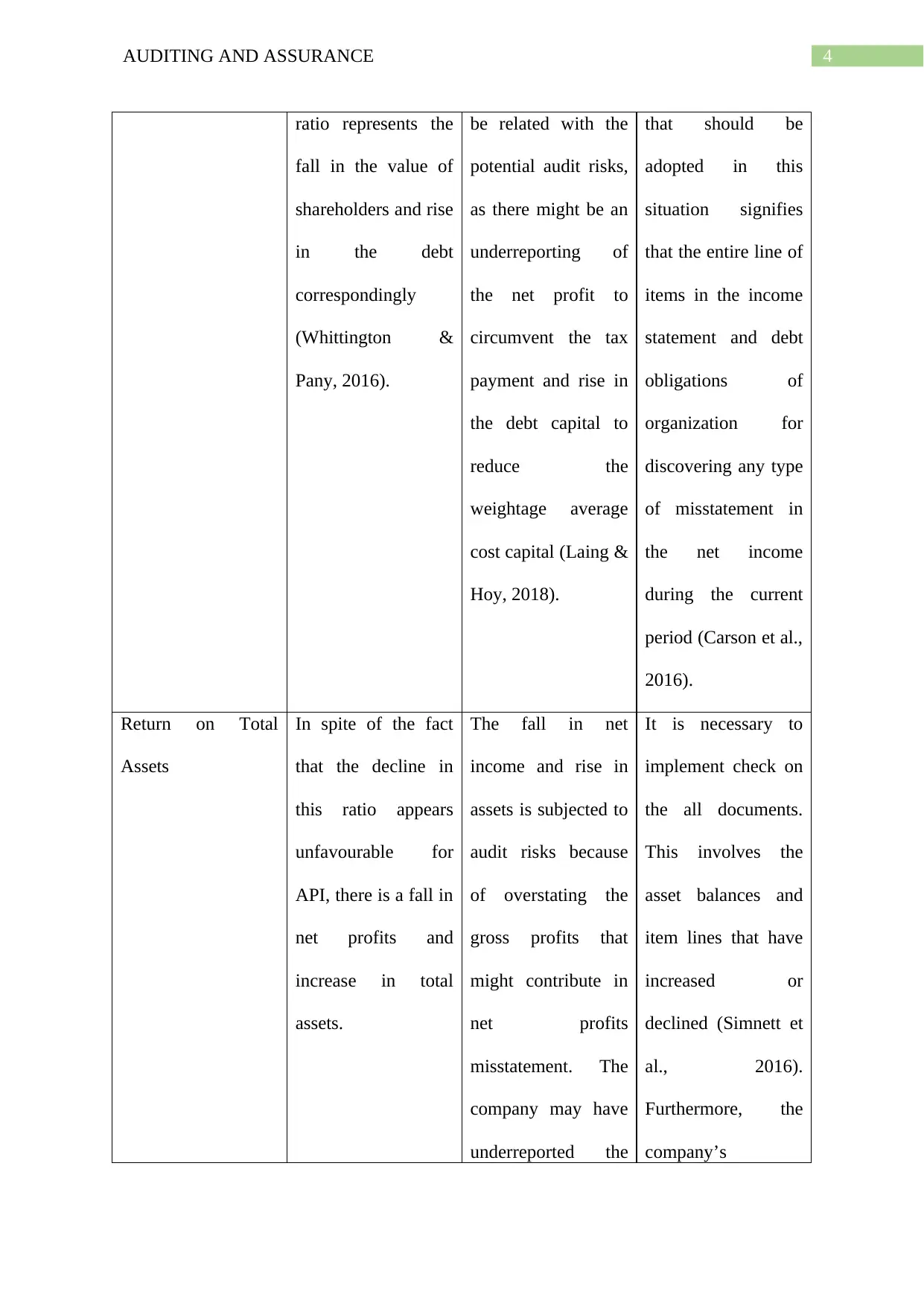
4AUDITING AND ASSURANCE
ratio represents the
fall in the value of
shareholders and rise
in the debt
correspondingly
(Whittington &
Pany, 2016).
be related with the
potential audit risks,
as there might be an
underreporting of
the net profit to
circumvent the tax
payment and rise in
the debt capital to
reduce the
weightage average
cost capital (Laing &
Hoy, 2018).
that should be
adopted in this
situation signifies
that the entire line of
items in the income
statement and debt
obligations of
organization for
discovering any type
of misstatement in
the net income
during the current
period (Carson et al.,
2016).
Return on Total
Assets
In spite of the fact
that the decline in
this ratio appears
unfavourable for
API, there is a fall in
net profits and
increase in total
assets.
The fall in net
income and rise in
assets is subjected to
audit risks because
of overstating the
gross profits that
might contribute in
net profits
misstatement. The
company may have
underreported the
It is necessary to
implement check on
the all documents.
This involves the
asset balances and
item lines that have
increased or
declined (Simnett et
al., 2016).
Furthermore, the
company’s
ratio represents the
fall in the value of
shareholders and rise
in the debt
correspondingly
(Whittington &
Pany, 2016).
be related with the
potential audit risks,
as there might be an
underreporting of
the net profit to
circumvent the tax
payment and rise in
the debt capital to
reduce the
weightage average
cost capital (Laing &
Hoy, 2018).
that should be
adopted in this
situation signifies
that the entire line of
items in the income
statement and debt
obligations of
organization for
discovering any type
of misstatement in
the net income
during the current
period (Carson et al.,
2016).
Return on Total
Assets
In spite of the fact
that the decline in
this ratio appears
unfavourable for
API, there is a fall in
net profits and
increase in total
assets.
The fall in net
income and rise in
assets is subjected to
audit risks because
of overstating the
gross profits that
might contribute in
net profits
misstatement. The
company may have
underreported the
It is necessary to
implement check on
the all documents.
This involves the
asset balances and
item lines that have
increased or
declined (Simnett et
al., 2016).
Furthermore, the
company’s
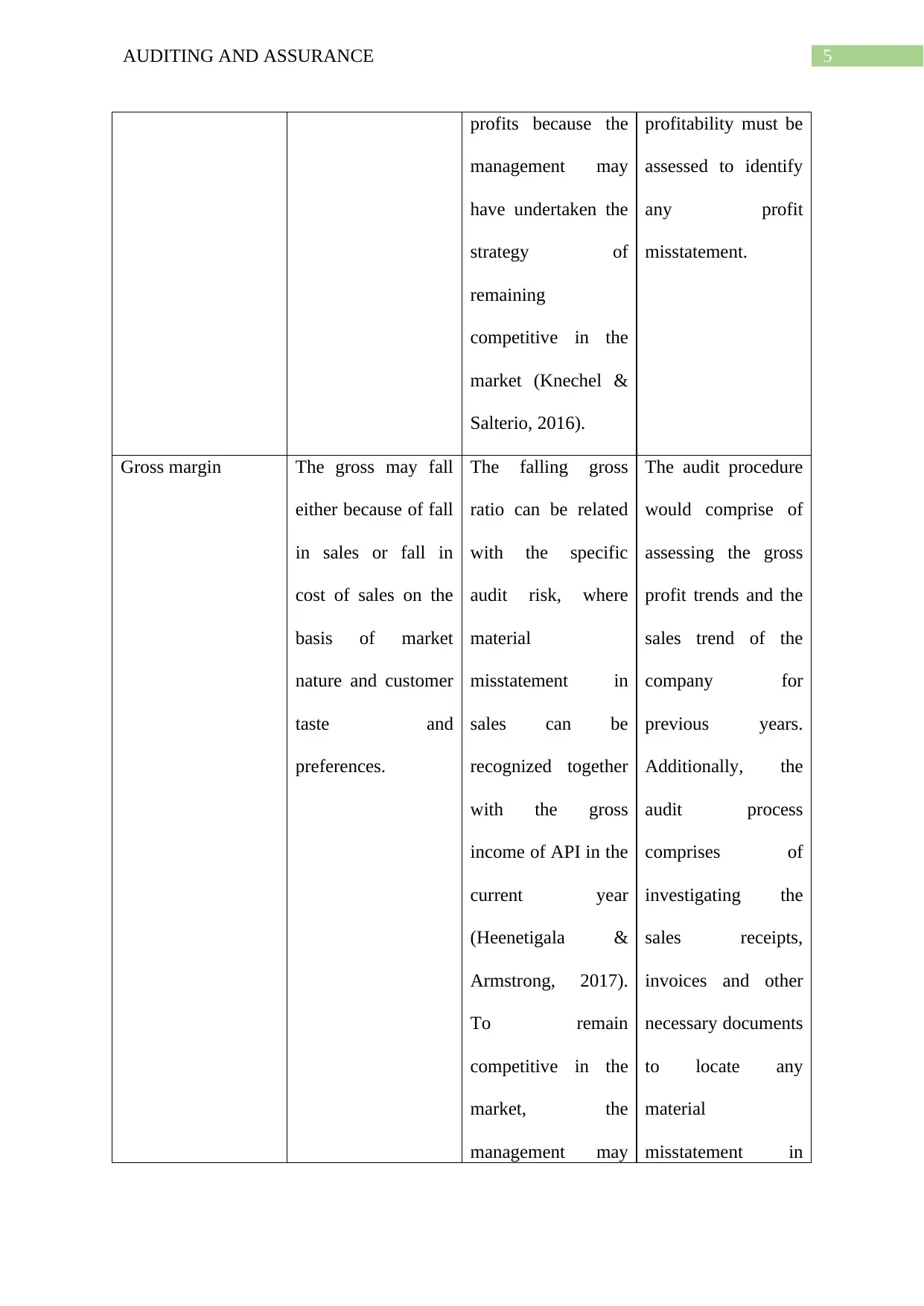
5AUDITING AND ASSURANCE
profits because the
management may
have undertaken the
strategy of
remaining
competitive in the
market (Knechel &
Salterio, 2016).
profitability must be
assessed to identify
any profit
misstatement.
Gross margin The gross may fall
either because of fall
in sales or fall in
cost of sales on the
basis of market
nature and customer
taste and
preferences.
The falling gross
ratio can be related
with the specific
audit risk, where
material
misstatement in
sales can be
recognized together
with the gross
income of API in the
current year
(Heenetigala &
Armstrong, 2017).
To remain
competitive in the
market, the
management may
The audit procedure
would comprise of
assessing the gross
profit trends and the
sales trend of the
company for
previous years.
Additionally, the
audit process
comprises of
investigating the
sales receipts,
invoices and other
necessary documents
to locate any
material
misstatement in
profits because the
management may
have undertaken the
strategy of
remaining
competitive in the
market (Knechel &
Salterio, 2016).
profitability must be
assessed to identify
any profit
misstatement.
Gross margin The gross may fall
either because of fall
in sales or fall in
cost of sales on the
basis of market
nature and customer
taste and
preferences.
The falling gross
ratio can be related
with the specific
audit risk, where
material
misstatement in
sales can be
recognized together
with the gross
income of API in the
current year
(Heenetigala &
Armstrong, 2017).
To remain
competitive in the
market, the
management may
The audit procedure
would comprise of
assessing the gross
profit trends and the
sales trend of the
company for
previous years.
Additionally, the
audit process
comprises of
investigating the
sales receipts,
invoices and other
necessary documents
to locate any
material
misstatement in
⊘ This is a preview!⊘
Do you want full access?
Subscribe today to unlock all pages.

Trusted by 1+ million students worldwide

6AUDITING AND ASSURANCE
underreport the
gross profits.
sales figure of the
company (Gay &
Simnett, 2017).
Marketing
expenditure
Rising market
expenditure of API
can be considered in
the current year and
it is below the
industry standard.
Nevertheless, the
market expenditure
has direct effect on
the net profit of the
organization
(Fernandez-Feijoo et
al., 2016).
This aspect will be
subjected to audit
risks, because the
market expenditure
may represent higher
than the actual
figures leading to
decline in the net
income. With the
increase in the
expenditure, the
management of API
gets the scope of
sales related
expenditure in
relation with the
adopted plan.
The necessary
auditing procedure
that must be adopted
to deal with this
aspect is to perform
review and verifying
the market
expenditure to
recognize any form
of misstatement. As
a result, the auditor
may be required to
assess the bills,
vouchers and
receipts related to
market expenses
(Becker et al., 2015).
Administrative
expenditure/sales
There is a fall in
administrative
expenses of API in
the present year, that
bears a resemblance
The ratio however
relates with audit
risk associated to
underreporting of
administrative
The audit process
under this
circumstances is to
scrutinize the
documents such as
underreport the
gross profits.
sales figure of the
company (Gay &
Simnett, 2017).
Marketing
expenditure
Rising market
expenditure of API
can be considered in
the current year and
it is below the
industry standard.
Nevertheless, the
market expenditure
has direct effect on
the net profit of the
organization
(Fernandez-Feijoo et
al., 2016).
This aspect will be
subjected to audit
risks, because the
market expenditure
may represent higher
than the actual
figures leading to
decline in the net
income. With the
increase in the
expenditure, the
management of API
gets the scope of
sales related
expenditure in
relation with the
adopted plan.
The necessary
auditing procedure
that must be adopted
to deal with this
aspect is to perform
review and verifying
the market
expenditure to
recognize any form
of misstatement. As
a result, the auditor
may be required to
assess the bills,
vouchers and
receipts related to
market expenses
(Becker et al., 2015).
Administrative
expenditure/sales
There is a fall in
administrative
expenses of API in
the present year, that
bears a resemblance
The ratio however
relates with audit
risk associated to
underreporting of
administrative
The audit process
under this
circumstances is to
scrutinize the
documents such as
Paraphrase This Document
Need a fresh take? Get an instant paraphrase of this document with our AI Paraphraser

7AUDITING AND ASSURANCE
to budgeted ratio.
The movement
showcase positive
sign with respect to
business profitability
for API.
expenditure that
aligns with API
business strategy.
The main incentive
of management is to
minimize the costs
particularly the
selling expenditure
(Gay & Simnett,
2017).
receipts, bills,
vouchers and others
related to
administrative
expenditure of API
to determine the
misstatement in
those expenses.
Times interest
earned
Fall in this ratio
reflect that API may
not have adequate
amount of profits to
cover its interest
payments. The fall
in long term debt
may be considered
significant for the
company.
The risk related with
the potential audit is
the manipulation in
profits by the
management that
ultimately reduces
the company’s
ability to incur
interest. The debt
position of API may
be the subject of
understatement
being the part of
current strategy for
the company
Under this
circumstances, the
audit process
involves
investigating the
revenues of API to
detect any
possibilities of
manipulation. The
auditor is also
required to review
the position of debt
in order to determine
any sort of material
misstatement
to budgeted ratio.
The movement
showcase positive
sign with respect to
business profitability
for API.
expenditure that
aligns with API
business strategy.
The main incentive
of management is to
minimize the costs
particularly the
selling expenditure
(Gay & Simnett,
2017).
receipts, bills,
vouchers and others
related to
administrative
expenditure of API
to determine the
misstatement in
those expenses.
Times interest
earned
Fall in this ratio
reflect that API may
not have adequate
amount of profits to
cover its interest
payments. The fall
in long term debt
may be considered
significant for the
company.
The risk related with
the potential audit is
the manipulation in
profits by the
management that
ultimately reduces
the company’s
ability to incur
interest. The debt
position of API may
be the subject of
understatement
being the part of
current strategy for
the company
Under this
circumstances, the
audit process
involves
investigating the
revenues of API to
detect any
possibilities of
manipulation. The
auditor is also
required to review
the position of debt
in order to determine
any sort of material
misstatement
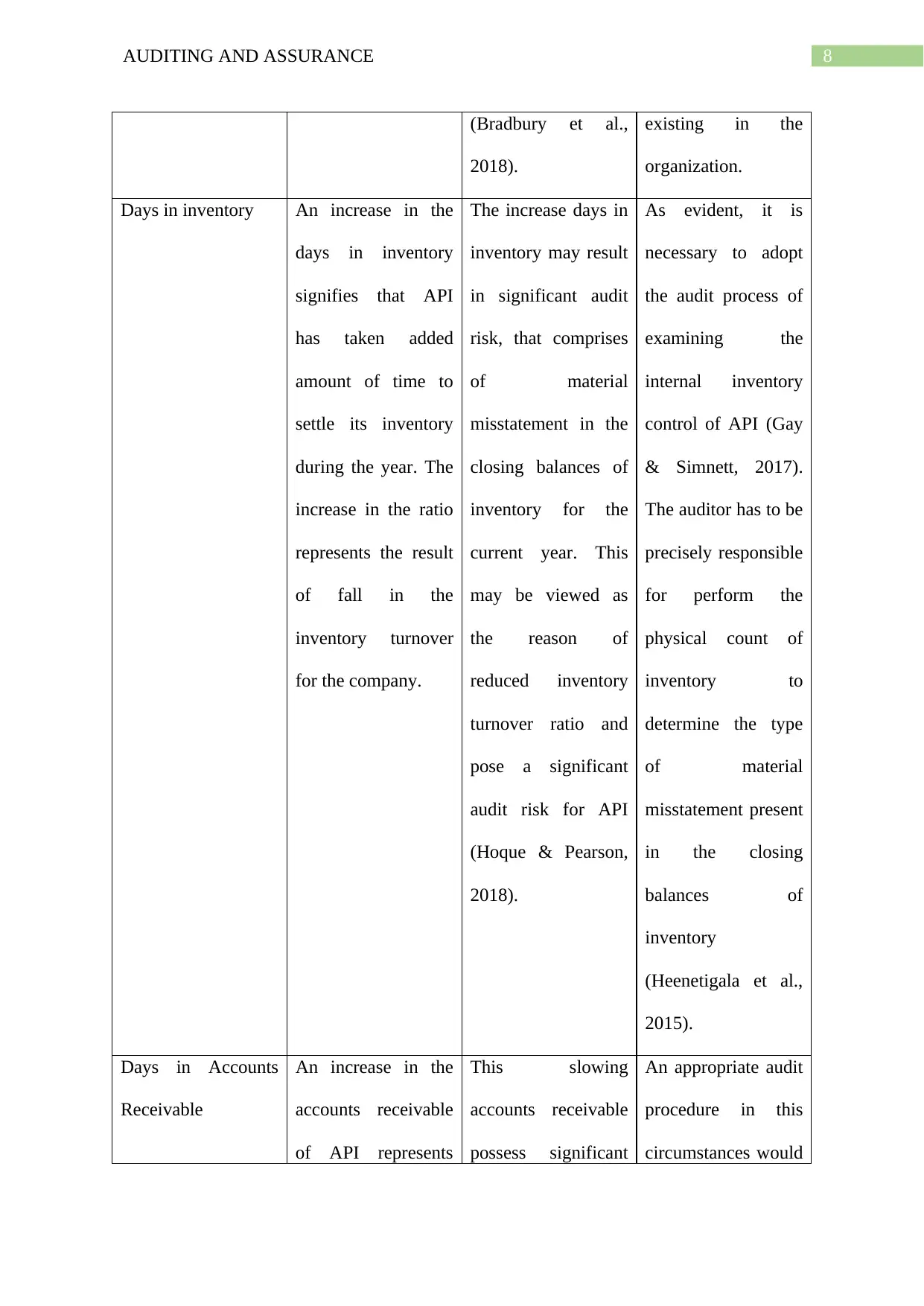
8AUDITING AND ASSURANCE
(Bradbury et al.,
2018).
existing in the
organization.
Days in inventory An increase in the
days in inventory
signifies that API
has taken added
amount of time to
settle its inventory
during the year. The
increase in the ratio
represents the result
of fall in the
inventory turnover
for the company.
The increase days in
inventory may result
in significant audit
risk, that comprises
of material
misstatement in the
closing balances of
inventory for the
current year. This
may be viewed as
the reason of
reduced inventory
turnover ratio and
pose a significant
audit risk for API
(Hoque & Pearson,
2018).
As evident, it is
necessary to adopt
the audit process of
examining the
internal inventory
control of API (Gay
& Simnett, 2017).
The auditor has to be
precisely responsible
for perform the
physical count of
inventory to
determine the type
of material
misstatement present
in the closing
balances of
inventory
(Heenetigala et al.,
2015).
Days in Accounts
Receivable
An increase in the
accounts receivable
of API represents
This slowing
accounts receivable
possess significant
An appropriate audit
procedure in this
circumstances would
(Bradbury et al.,
2018).
existing in the
organization.
Days in inventory An increase in the
days in inventory
signifies that API
has taken added
amount of time to
settle its inventory
during the year. The
increase in the ratio
represents the result
of fall in the
inventory turnover
for the company.
The increase days in
inventory may result
in significant audit
risk, that comprises
of material
misstatement in the
closing balances of
inventory for the
current year. This
may be viewed as
the reason of
reduced inventory
turnover ratio and
pose a significant
audit risk for API
(Hoque & Pearson,
2018).
As evident, it is
necessary to adopt
the audit process of
examining the
internal inventory
control of API (Gay
& Simnett, 2017).
The auditor has to be
precisely responsible
for perform the
physical count of
inventory to
determine the type
of material
misstatement present
in the closing
balances of
inventory
(Heenetigala et al.,
2015).
Days in Accounts
Receivable
An increase in the
accounts receivable
of API represents
This slowing
accounts receivable
possess significant
An appropriate audit
procedure in this
circumstances would
⊘ This is a preview!⊘
Do you want full access?
Subscribe today to unlock all pages.

Trusted by 1+ million students worldwide
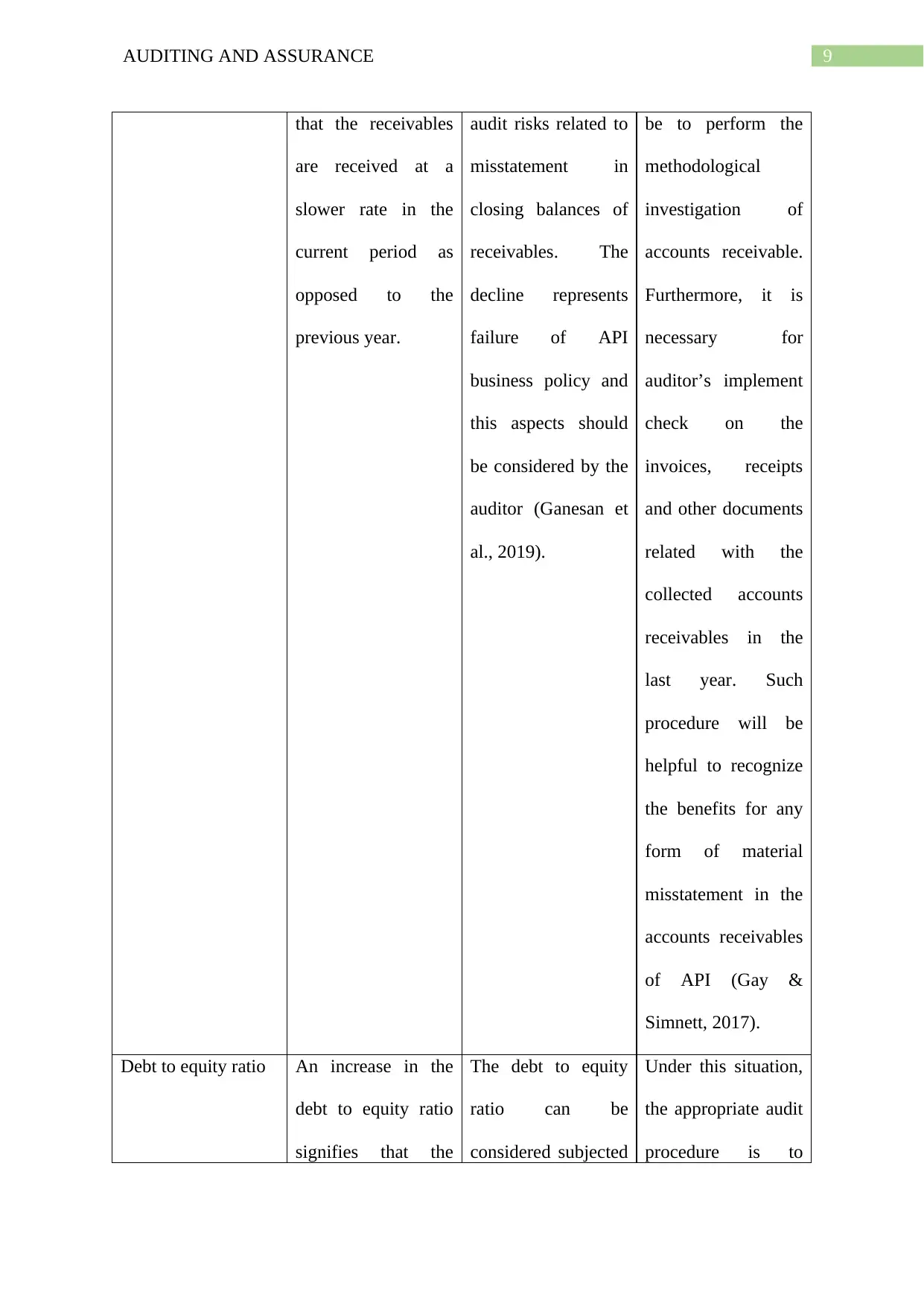
9AUDITING AND ASSURANCE
that the receivables
are received at a
slower rate in the
current period as
opposed to the
previous year.
audit risks related to
misstatement in
closing balances of
receivables. The
decline represents
failure of API
business policy and
this aspects should
be considered by the
auditor (Ganesan et
al., 2019).
be to perform the
methodological
investigation of
accounts receivable.
Furthermore, it is
necessary for
auditor’s implement
check on the
invoices, receipts
and other documents
related with the
collected accounts
receivables in the
last year. Such
procedure will be
helpful to recognize
the benefits for any
form of material
misstatement in the
accounts receivables
of API (Gay &
Simnett, 2017).
Debt to equity ratio An increase in the
debt to equity ratio
signifies that the
The debt to equity
ratio can be
considered subjected
Under this situation,
the appropriate audit
procedure is to
that the receivables
are received at a
slower rate in the
current period as
opposed to the
previous year.
audit risks related to
misstatement in
closing balances of
receivables. The
decline represents
failure of API
business policy and
this aspects should
be considered by the
auditor (Ganesan et
al., 2019).
be to perform the
methodological
investigation of
accounts receivable.
Furthermore, it is
necessary for
auditor’s implement
check on the
invoices, receipts
and other documents
related with the
collected accounts
receivables in the
last year. Such
procedure will be
helpful to recognize
the benefits for any
form of material
misstatement in the
accounts receivables
of API (Gay &
Simnett, 2017).
Debt to equity ratio An increase in the
debt to equity ratio
signifies that the
The debt to equity
ratio can be
considered subjected
Under this situation,
the appropriate audit
procedure is to
Paraphrase This Document
Need a fresh take? Get an instant paraphrase of this document with our AI Paraphraser
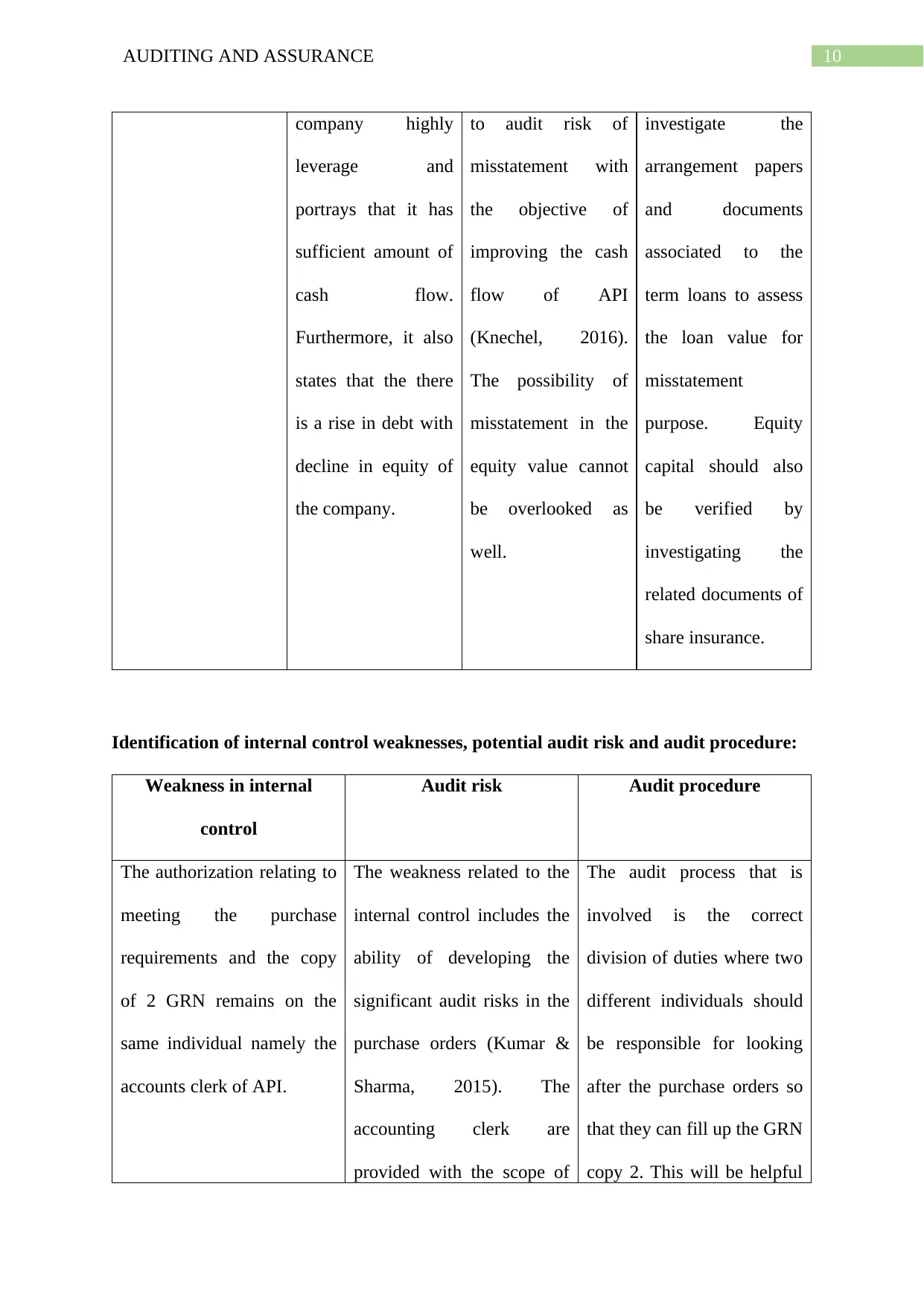
10AUDITING AND ASSURANCE
company highly
leverage and
portrays that it has
sufficient amount of
cash flow.
Furthermore, it also
states that the there
is a rise in debt with
decline in equity of
the company.
to audit risk of
misstatement with
the objective of
improving the cash
flow of API
(Knechel, 2016).
The possibility of
misstatement in the
equity value cannot
be overlooked as
well.
investigate the
arrangement papers
and documents
associated to the
term loans to assess
the loan value for
misstatement
purpose. Equity
capital should also
be verified by
investigating the
related documents of
share insurance.
Identification of internal control weaknesses, potential audit risk and audit procedure:
Weakness in internal
control
Audit risk Audit procedure
The authorization relating to
meeting the purchase
requirements and the copy
of 2 GRN remains on the
same individual namely the
accounts clerk of API.
The weakness related to the
internal control includes the
ability of developing the
significant audit risks in the
purchase orders (Kumar &
Sharma, 2015). The
accounting clerk are
provided with the scope of
The audit process that is
involved is the correct
division of duties where two
different individuals should
be responsible for looking
after the purchase orders so
that they can fill up the GRN
copy 2. This will be helpful
company highly
leverage and
portrays that it has
sufficient amount of
cash flow.
Furthermore, it also
states that the there
is a rise in debt with
decline in equity of
the company.
to audit risk of
misstatement with
the objective of
improving the cash
flow of API
(Knechel, 2016).
The possibility of
misstatement in the
equity value cannot
be overlooked as
well.
investigate the
arrangement papers
and documents
associated to the
term loans to assess
the loan value for
misstatement
purpose. Equity
capital should also
be verified by
investigating the
related documents of
share insurance.
Identification of internal control weaknesses, potential audit risk and audit procedure:
Weakness in internal
control
Audit risk Audit procedure
The authorization relating to
meeting the purchase
requirements and the copy
of 2 GRN remains on the
same individual namely the
accounts clerk of API.
The weakness related to the
internal control includes the
ability of developing the
significant audit risks in the
purchase orders (Kumar &
Sharma, 2015). The
accounting clerk are
provided with the scope of
The audit process that is
involved is the correct
division of duties where two
different individuals should
be responsible for looking
after the purchase orders so
that they can fill up the GRN
copy 2. This will be helpful
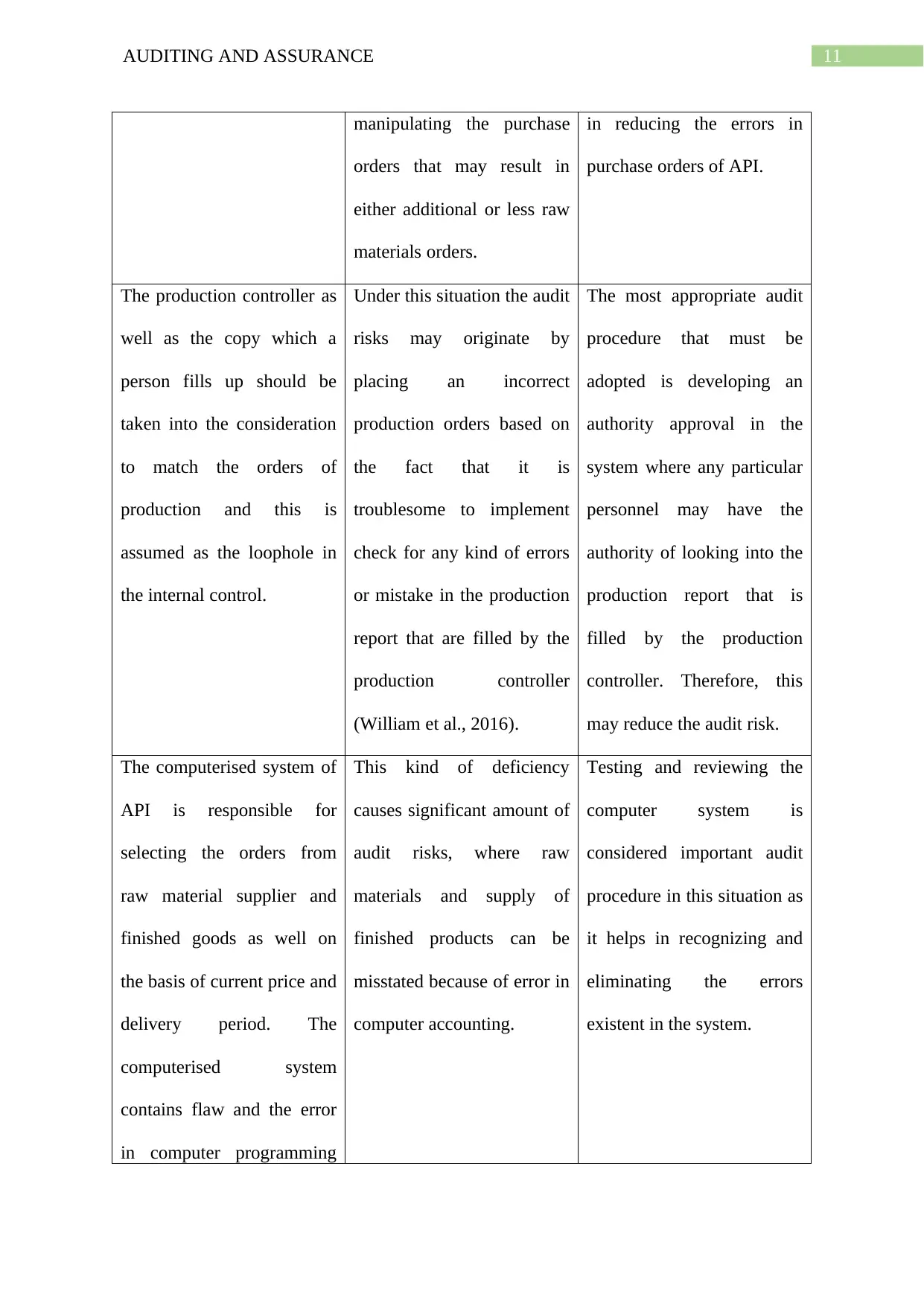
11AUDITING AND ASSURANCE
manipulating the purchase
orders that may result in
either additional or less raw
materials orders.
in reducing the errors in
purchase orders of API.
The production controller as
well as the copy which a
person fills up should be
taken into the consideration
to match the orders of
production and this is
assumed as the loophole in
the internal control.
Under this situation the audit
risks may originate by
placing an incorrect
production orders based on
the fact that it is
troublesome to implement
check for any kind of errors
or mistake in the production
report that are filled by the
production controller
(William et al., 2016).
The most appropriate audit
procedure that must be
adopted is developing an
authority approval in the
system where any particular
personnel may have the
authority of looking into the
production report that is
filled by the production
controller. Therefore, this
may reduce the audit risk.
The computerised system of
API is responsible for
selecting the orders from
raw material supplier and
finished goods as well on
the basis of current price and
delivery period. The
computerised system
contains flaw and the error
in computer programming
This kind of deficiency
causes significant amount of
audit risks, where raw
materials and supply of
finished products can be
misstated because of error in
computer accounting.
Testing and reviewing the
computer system is
considered important audit
procedure in this situation as
it helps in recognizing and
eliminating the errors
existent in the system.
manipulating the purchase
orders that may result in
either additional or less raw
materials orders.
in reducing the errors in
purchase orders of API.
The production controller as
well as the copy which a
person fills up should be
taken into the consideration
to match the orders of
production and this is
assumed as the loophole in
the internal control.
Under this situation the audit
risks may originate by
placing an incorrect
production orders based on
the fact that it is
troublesome to implement
check for any kind of errors
or mistake in the production
report that are filled by the
production controller
(William et al., 2016).
The most appropriate audit
procedure that must be
adopted is developing an
authority approval in the
system where any particular
personnel may have the
authority of looking into the
production report that is
filled by the production
controller. Therefore, this
may reduce the audit risk.
The computerised system of
API is responsible for
selecting the orders from
raw material supplier and
finished goods as well on
the basis of current price and
delivery period. The
computerised system
contains flaw and the error
in computer programming
This kind of deficiency
causes significant amount of
audit risks, where raw
materials and supply of
finished products can be
misstated because of error in
computer accounting.
Testing and reviewing the
computer system is
considered important audit
procedure in this situation as
it helps in recognizing and
eliminating the errors
existent in the system.
⊘ This is a preview!⊘
Do you want full access?
Subscribe today to unlock all pages.

Trusted by 1+ million students worldwide
1 out of 21
Related Documents
Your All-in-One AI-Powered Toolkit for Academic Success.
+13062052269
info@desklib.com
Available 24*7 on WhatsApp / Email
![[object Object]](/_next/static/media/star-bottom.7253800d.svg)
Unlock your academic potential
Copyright © 2020–2025 A2Z Services. All Rights Reserved. Developed and managed by ZUCOL.





